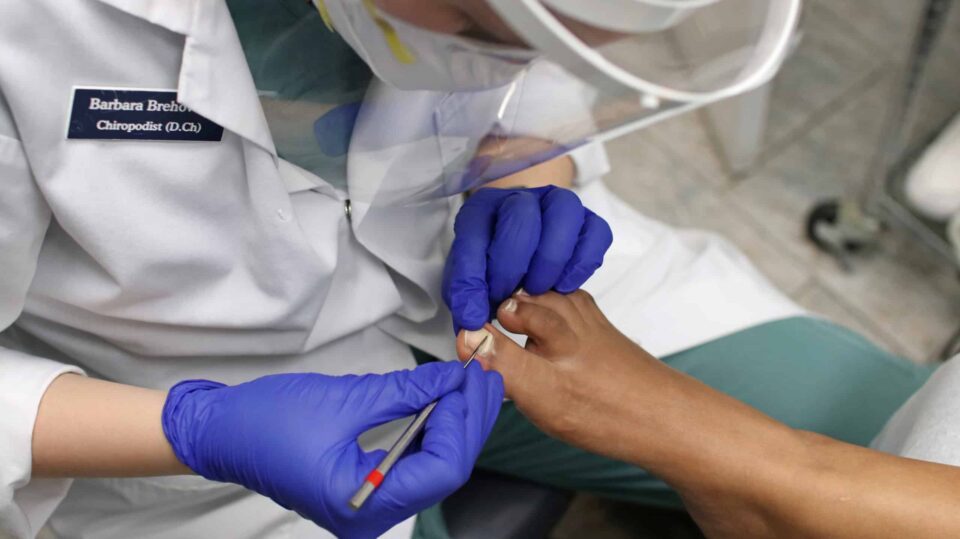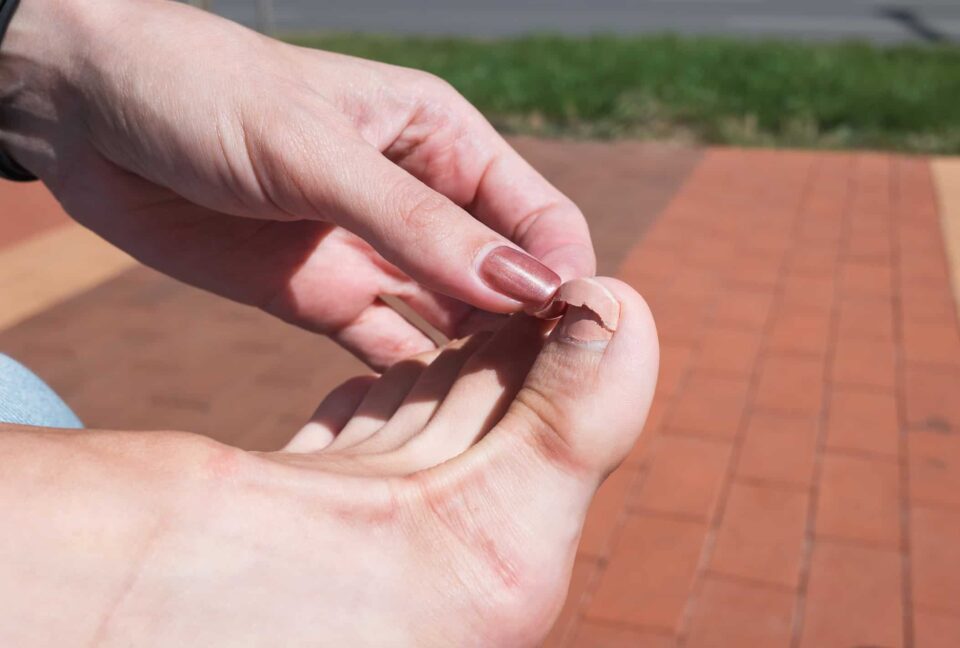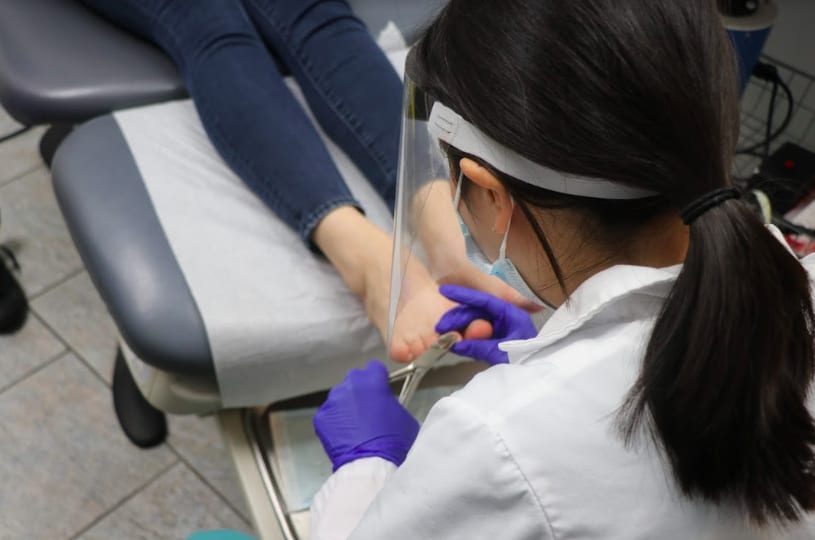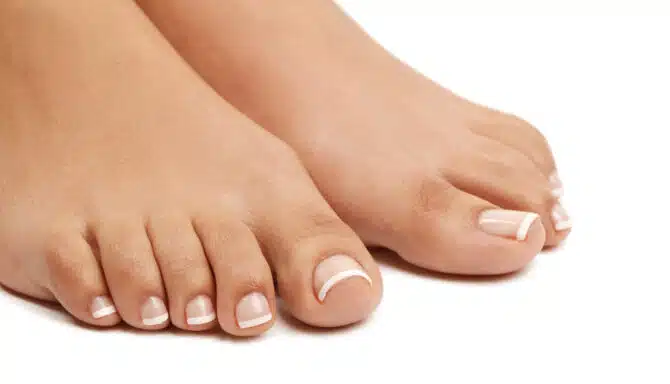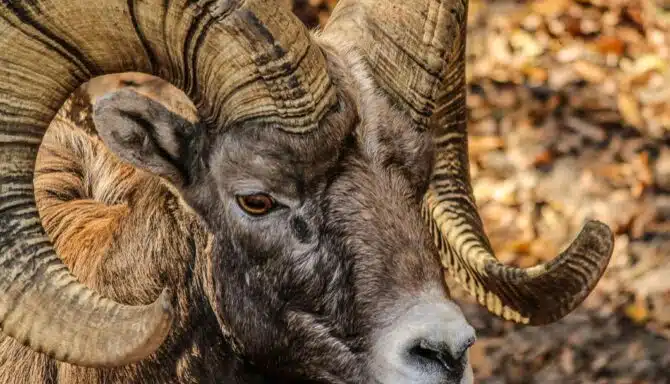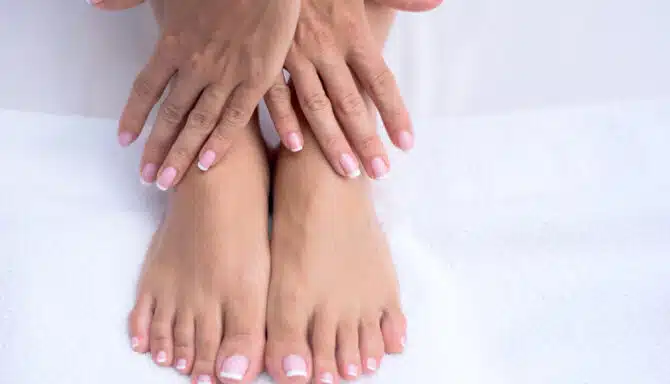September 18, 2025
Toenail health is an important part of overall foot care, yet conditions like involuted toenails often go unnoticed until discomfort arises. If you’ve noticed your toenails curling inward or becoming unusually curved, you might be dealing with an involuted toenail. Understanding this condition can help you manage symptoms and seek proper treatment before complications occur.
What Are Involuted Toenails?
Involuted toenails, also called curved or pincer nails, occur when the edges of the toenail curl inward toward the skin. This excessive curvature can cause the nail to pinch the nail bed and surrounding skin, leading to discomfort or pain. It also makes them prone to becoming ingrown.
Causes of Involuted Toenails
Several factors can contribute to the development of involuted toenails, including:
Genetics: Some people inherit a tendency toward curved toenails.
Improper Footwear: Tight, narrow shoes can exert pressure on the nails, encouraging them to curl.
Injury: Trauma to the toe can alter nail growth patterns.
Fungal Infections: Nail infections may cause thickening and distortion of the nail plate.
Aging: Toenail shape and growth can change with age.
Underlying Medical Conditions: Certain diseases like psoriasis or circulatory problems may affect nail health.
Symptoms to Watch For
Toenails that curve sharply inward, sometimes forming a tube shape.
Discomfort or pain along the sides of the toenail.
Redness, swelling, or signs of infection around the nail edges.
Difficulty trimming nails due to their shape.
Formation of calluses or corns near the nail edges.
Treatment Options for Involuted Toenails
Conservative Care
Proper Footwear: Choose shoes with wide toe boxes to reduce pressure.
Regular Nail Care: Careful trimming and filing can help manage nail shape.
Moisturizing: Keeping nails and surrounding skin hydrated may reduce brittleness.
Padding: Using protective pads can cushion the nail and reduce irritation.
Medical and Professional Treatments
Nail Bracing or OnyFix: Special braces can gently correct nail curvature over time.
Debridement: A podiatrist can carefully trim thickened or curved nails.
Treatment of Infections: Antifungal medications if infection is present.
Surgical Options: In severe cases, part or all of the nail may be removed to relieve pain and prevent recurrence.
When to See a Foot Specialist
If you experience persistent pain, signs of infection, or difficulty managing your involuted toenails, it’s important to consult a foot care professional. Early intervention can prevent complications such as ingrown nails or infections.
You should also see a specialist if you find you're having difficulty trimming your toenails; curved toenails are notoriously difficult to trim.
July 24, 2025
Running is great for your overall health but your toenails might disagree. Many runners deal with painful or unsightly toenail problems, especially after long distances or hill training. Issues are so common that "runner's toenails" is a commonly used term to describe all the toenail damage. Understanding how running impacts toenail health can help you prevent injury and keep your feet in peak condition.
View this post on Instagram A post shared by Feet First Clinic (@feetfirstclinic_)
Common Toenail Issues Runners Experience
Black Toenail from Running (Subungual Hematoma): One of the most recognizable issues, a black toenail develops when repeated impact causes bruising or bleeding under the nail. It’s often due to shoes that are too tight or downhill running.
Toenail Lifting or Falling Off: Constant pressure on the nail bed can cause nails to lift or fall off completely, especially after a marathon or long run. This is usually painless, but it takes months for the nail to regrow.
Thick Toenails After Running: Repeated trauma can lead to thickened toenails, which may resemble fungal infections. This thickening is the nail’s response to long-term micro-damage and may become permanent if untreated.
Ingrown Toenails: Tight shoes or improper nail trimming can lead to ingrown toenails, which are common among runners and can become infected if ignored.
What Causes Running-Related Toenail Damage?
Improper shoe fit: Shoes that are too tight, too loose, or worn out can lead to friction and trauma.
Long toenails: Long nails hit the front of the shoe with every stride, increasing the risk of bruising or lifting.
Downhill running: Increases the impact on the toes.
Sweaty feet: Create a moist environment that can encourage fungal growth.
Inadequate socks: Thin or poorly fitted socks allow for extra movement inside the shoe.
Runner’s Toenail Care: Prevention Tips
Trim your nails regularly – Straight across, not too short, and never rounded at the corners.
Wear proper footwear – Choose shoes with about a thumb’s width of space at the front, and consider a running-specific fit.
Choose the right socks – Moisture-wicking and snug, with no bunching or seams that rub.
Replace shoes as needed – Most running shoes last 500–800 km. Worn-out soles contribute to poor foot mechanics.
Moisturize your feet – Prevent cracking and fungal buildup with a good daily foot care routine.
When to See a Foot Specialist
If your "runner's toenails" are persistently discoloured, painful, or thickened, it’s time for a professional assessment. What seems like a harmless black toenail from running could be a fungal infection, ingrown nail, or even an injury needing care. A chiropodist or foot specialist can safely treat nail trauma, provide custom foot care advice, and help you run pain-free.
View this post on Instagram A post shared by Feet First Clinic (@feetfirstclinic_)
Final Thought
You train hard so don’t let toenail trouble slow you down. By caring for your feet proactively, you can avoid common nail issues and keep running comfortably year-round.
April 10, 2025
Curved toenails can indicate various underlying toenail conditions, each with unique causes and additional characteristics. They also don’t always look the same. Toenail curvature issues can range from having a severe Ram’s Horn toenail, accompanied by other symptoms like thickening and discoloration, or small pincer nails that pierce your skin. Let’s learn about curved toenail causes, and most importantly, how a chiropodist or podiatrist can treat curved toenails at a foot clinic so complications don’t arise.
Why Do Toenails Curve?
https://www.youtube.com/shorts/Z6VYvI6CJQs
To understand the best ways of preventing curved toenails, it’s important to learn how healthy toenails grow. They should naturally grow forward in a slightly arched but mostly flat shape, following the contour of the toe. This process begins in the nail matrix, the tissue under the skin at the base of the nail, where specialized cells produce layers of keratin—the protein that makes up the nail.
As new cells form, older cells are pushed outward, harden, and form the visible nail plate. Ideally, the nail grows evenly and straight across, guided by both the shape of the matrix and the direction of mechanical forces applied to the toe, like walking or wearing shoes. The nail bed beneath provides support and helps keep the nail anchored and flat as it grows. A balance between nail thickness, width, and surrounding skin tension is key to maintaining this typical shape.
Toenails start to curve when something disrupts this balance.
Repetitive Trauma from Ill-Fitting Footwear
One common reason is uneven pressure and toe crowding. Tight footwear or repetitive trauma can push the nail’s edges downward or inward over time. That’s why one of the best ways of preventing curved toenails, or virtually all foot conditions for that matter, is purchasing and wearing only shoes that fit properly, allow your toes to splay comfortably, and have ample cushioning, arch support and shock absorption. It’s better to have a small selection of solid, high-quality shoes that support foot health than several pairs of low-quality, poorly designed shoes that cramp your toes.
https://www.youtube.com/shorts/rwNLRZ-MN_M
Genetics
Genetics also play a role in abnormal toenail growth; some people naturally have a more curved nail matrix or a narrower nail bed, both of which can encourage curling. If keratin production is uneven—say, one side of the nail grows faster than the other—the nail can begin to twist or curve as it extends.
Underlying Health Conditions
Inflammatory conditions, infections, poor circulation, or chronic diseases like diabetes can also interfere with normal nail growth by altering cell turnover in the matrix or causing changes to the skin and tissue around the nail. As a result, curved toenails are often not just a cosmetic issue—they can signal deeper structural or health-related concerns.
Curved Toenail Causes
Whether your curled toenails are the result of a sinister condition or simply a genetic growth pattern you’ve inherited, preventing them from getting worse is key. No matter the cause, proper trimming (straight across with simple nail clippers) and wearing shoes that fit well are two of the best things you can do from home to prevent painful complications and live life as comfortably as possible. Below you’ll find some of the most common causes of curved toenails:
Ingrown Toenails (Onychocryptosis)
Ingrown toenails are tricky as they look deceptively mild. But complications, like painful infections, can arise if you ignore them. They develop when the edge of a curved toenail grows into the surrounding skin, causing swelling, redness, and sensitivity. They can look curved, but they also look like a small “extra nail” on the edge of the main nail. It most commonly affects the big toe, and naturally curved toenails (involuted nails) are more likely to become ingrown because their growth pattern is already unusual.
Trimming the nails too short or rounding the edges can also encourage the skin to fold over the nail edge, allowing it to grow inward instead of outward. Repeated pressure or trauma from sports, stubbing the toe, or restrictive footwear (in the toe box, like narrow, pointed high heels) can also disrupt normal growth and set the stage for an ingrown nail to form.
https://www.youtube.com/shorts/B5a3yIgokh8
Pincer Nails (Trumpet Nails)
Classified by podiatrists and chiropodists as “the most painful type of ingrown toenail,” pincer nails, or trumpet nails, occur when the sides of the toenail curve inward toward each other, sometimes so dramatically that the edges look like they want to meet underneath the toe!
This shape creates a pinching effect on the nail bed and surrounding tissue. While some people are born with a naturally curved nail structure that gradually tightens over time, others develop this condition due to external pressures. Long-term use of tight shoes, particularly those with narrow toe boxes, is a major contributing factor. Certain systemic conditions, such as autoimmune disorders or circulatory problems, may also affect the nail matrix and contribute to this unusual curvature. Additionally, aging can play a role, as nail shape and growth patterns tend to change over time.
Onychogryphosis (Ram’s Horn Nails)
View this post on Instagram A post shared by Feet First Clinic (@feetfirstclinic_)
Onychogryphosis is a condition where the toenail becomes dramatically thickened and begins to grow in a distorted, curved, or spiraled shape that resembles a ram’s horn. It often affects the big toe and progresses gradually over time. The nail’s irregular growth is usually the result of uneven cell production in the nail matrix, where one side grows faster than the other.
The most common causes include repetitive trauma (like years of wearing ill-fitted shoes), long-standing fungal infections, or neglect of nail trimming. It’s more frequently seen in older adults or individuals with limited mobility who may struggle with basic foot care. Certain systemic conditions, including psoriasis and vascular disorders, may also interfere with healthy nail growth and lead to this thickened, curved form.
Curved Toenail Pain Relief and Solutions: Nail Disorder Treatment
Toenail curvature can cause pain and nagging discomfort that disrupts your daily life. Remember, the nail should not be growing this way, and it’s up to you to take the first step towards finding a solution. Chiropodists and podiatrists offer several effective treatments to address curved toenails, tailored to the severity and underlying causes. Below are some common treatments available at foot clinics:
Proper Fitting Footwear
Wearing shoes that are the correct length 0with a wide toe box is crucial for preventing and alleviating discomfort associated with curved toenails. Footwear that allows ample space for the toes reduces pressure on the toenails, minimizing the risk of them growing into the surrounding skin. Properly fitting shoes not only aid in preventing the development or worsening of curved toenails, but also provide some pain relief for existing conditions that need accommodation. Ensuring that shoes complement the natural shape of the foot without squeezing or compressing the toes is a simple yet effective measure in maintaining toenail health.
Medical Pedicures
Medical pedicures are performed by trained chiropodists or podiatrists and focus on the health and hygiene of the feet and nails. Unlike cosmetic pedicures, these procedures address underlying issues and focus more on nail maintenance and health than aesthetic appearances (although the nails always look clean and fresh afterwards!). During a medical pedicure, the specialist will carefully trim and reshape the toenails using sterilized instruments, reducing the risk of further complications.
They are a common treatment for people with diabetes who cannot cut and clean their nails properly without assistance, and who need an extra set of eyes and expertise to spot abnormalities.
OnyFix Nail Correction System
The OnyFix system is a non-invasive, highly innovative, and pain-free treatment designed to correct curved toenails—especially ingrown toenails. It involves applying a specialized composite material to the nail, which hardens and acts as a brace, guiding the nail to grow in its natural shape without exerting direct force. This method is suitable for various nail shapes and is particularly beneficial for patients seeking an alternative to surgical interventions. The Onyfix system allows individuals to continue their daily activities without restrictions, including swimming and wearing nail polish.
https://www.youtube.com/shorts/LoCcoKOhV7E
Nail Avulsion Surgery
In severe cases, such as with ram's horn toenail, surgical intervention may be recommended. This procedure involves the partial or complete removal of the affected toenail under local anesthesia. By removing the deformed nail, the underlying tissue can heal properly, and a healthier nail may regrow. Alternatively, a solution called phenol may be used to prevent nail regrowth.
April 3, 2025
Healthy toenails need healthy circulation, but when blood flow is compromised, they can become brittle, discoloured, or grow slowly. Additional toenail conditions can also develop. Poor circulation and toenail problems are closely linked, especially for those with health problems like diabetes or peripheral artery disease. Understanding why poor blood flow affects toenails can help you take the right steps to protect your foot health and prevent complications.
https://www.youtube.com/shorts/3JAUqiqJfus
The Importance of Blood Circulation
In order to understand the link between poor circulation and toenail issues, we have to start by understanding what blood flow is and what it does. The circulatory system, comprising the heart, blood vessels, and blood, serves as the body's transportation network. Its primary function is to deliver oxygen and essential nutrients to cells while removing waste products like carbon dioxide.
The heart pumps oxygen-rich blood through arteries, which branch into smaller arterioles and capillaries, reaching every tissue and organ. This process ensures that each cell receives the necessary components for energy production, growth, and repair.
Efficient blood circulation is vital for overall health. Oxygen transported by red blood cells is crucial for cellular respiration, the process by which cells generate energy. Nutrients absorbed from digested food are distributed via the bloodstream to support various bodily functions.
Key nutrients delivered by the bloodstream include:
Glucose: A simple sugar derived from carbohydrates in our diet, glucose serves as the primary energy source for cells, fueling various physiological processes.
Amino Acids: These are the building blocks of proteins, obtained from the digestion of dietary proteins. Amino acids are crucial for tissue growth, repair, and the synthesis of enzymes and hormones.
Fatty Acids and Lipids: Essential components of cell membranes and energy storage molecules, fatty acids and lipids are transported to cells for incorporation into cellular structures and for energy production.
Vitamins and Minerals: These micronutrients support a range of cellular functions, including maintaining bone health and facilitating nerve transmission.
Hormones: Although not nutrients in the traditional sense, hormones are vital signaling molecules transported by the circulatory system to regulate various physiological activities, such as metabolism, growth, and mood.
Impaired circulation can slow down healing processes—even for seemingly innocent and minor problems like cuts and scrapes. Likewise, organs and tissues deprived of adequate circulation can suffer damage over time, increasing the risk of conditions such as peripheral artery disease, stroke, and heart attacks.
Toenail Health and Circulation: The Connection
The circulatory system delivers oxygen and essential nutrients to the nail beds, supporting the growth and maintenance of strong, clear nails. When blood flow is compromised, the nails may not receive adequate nourishment, leading to various issues such as brittleness, discoloration, and slowed growth. In some cases, poor circulation can cause nails to develop ridges, indicating underlying vascular problems.
Reduced blood flow can also increase the risk of infections like toenail fungus (onychomycosis). A weakened circulatory system impairs the body's ability to combat pathogens, making the toenail environment more susceptible to fungal overgrowth. This often results in yellowed, thickened nails that you can’t treat without the help of a chiropodist or podiatrist. They must remove the infected portion of the nail so they can apply the correct medicine.
Poor blood flow on its own may not cause a problem with your foot health, but it can contribute to the following toenail conditions:
Slow or halted nail growth: Inadequate blood flow deprives the nail matrix of essential nutrients and oxygen, resulting in reduced or ceased toenail growth. This can be very frustrating if your toenail falls off or cracks and you’re waiting for it to grow back, leaving your feet vulnerable.
Brittle and discolored nails: Insufficient circulation can cause nails to become brittle and change color, often appearing yellowed or darkened.
Thickened nails: Poor blood flow may contribute to the thickening of toenails, often via toenail fungus, making them difficult to trim and maintain. Poor blood flow also affects the nail growth process, which can cause nail cells to pile on top of each other and lead to thicker toenails.
Ingrown toenails: While not directly caused by poor circulation, individuals with compromised blood flow, such as those with diabetes, are at higher risk for complications from ingrown toenails, including infections and delayed healing.
Diabetes, Toenail Health and Circulation
Diabetes can lead to two significant complications affecting foot health: diabetic neuropathy and peripheral artery disease (PAD). Diabetic neuropathy results from prolonged high blood sugar levels damaging the nerves, particularly in the legs and feet, causing numbness, tingling, or a loss of sensation.
This diminished sensitivity means that innocent injuries, such as cuts or blisters, may go unnoticed, increasing the risk of infections and complications like ulcers, or in severe cases, life threatening problems like gangrene, which require amputation. This is also the case for seemingly minor problems with the toenails. Simultaneously, PAD causes blood vessels to narrow and harden, reducing blood flow to the extremities. This impaired circulation hampers the delivery of oxygen and essential nutrients needed for healing, making the feet and toenails even more susceptible.
Regular foot inspections and nail care with a chiropodist or podiatrist, maintaining proper hygiene, and promptly addressing any abnormalities are crucial steps for diabetics to prevent toenail-related complications stemming from poor blood flow.
https://www.youtube.com/shorts/QFWBwM6mGqM?feature=share
Foot and Nail Care for Poor Circulation
Maintaining proper foot and nail care is essential for individuals experiencing poor circulation, as reduced blood flow can lead to various complications. Here are some recommended practices and treatments:
https://youtu.be/5PCZuM5E6RU
Regular Exercise: Maintaining good circulatory health through regular exercise, a balanced diet, and avoiding smoking is essential for ensuring that the body's systems function as well as possible. One of the best circulation maintenance tips for foot health is working the muscles in the lower extremities. Exercises like toe splays, toe flexes and raises, massage ball rolls, pen pick-ups and seated toe pulls can work wonders. Click here to learn the five best foot exercises to improve blood circulation. They’re particularly helpful in the winter, but are useful all year round.
Regular Self Inspections: Conduct daily checks for cuts, sores, or changes in nail color and texture to detect issues early.
Moisturizing: Keep feet hydrated to prevent cracks and fissures that can lead to infections. Learn how to moisturize properly here.
OnyFix Nail Correction System: For those with ingrown or involuted toenails, the OnyFix system offers a non-invasive, pain-free solution. This innovative treatment involves applying a composite material to the nail, which helps guide it back to its natural shape as it grows, without the need for surgery. It's suitable for various nail shapes.
Medical Pedicures: Unlike traditional cosmetic pedicures, medical pedicures are performed by trained foot care professionals, such as chiropodists or podiatrists, in a sterile environment in a foot clinic. They focus on health, addressing issues like nail trimming, callus reduction, and infection prevention. They are especially helpful for dealing with irregular shaped toenails caused by poor circulation - cutting and maintaining these on your own can be very difficult. For people with diabetes, who are at higher risk for foot complications due to poor circulation and neuropathy, medical pedicures are a common and recommended treatment. These specialized pedicures help prevent complications like infections or ulcers by ensuring meticulous foot care.
Proper Footwear: Wear well-fitting shoes that provide adequate support and reduce pressure points to promote better circulation.
Proper Nail Trimming: Trim nails straight across and avoid cutting them too short to prevent ingrown toenails. And if your toenails are too thick or difficult to cut on your own, book an appointment with a foot specialist.
March 20, 2025
Ram’s horn toenails? Sounds like a serious foot issue! And it is—this condition, medically known as onychogryphosis, causes thickened, curved nails that can become painful and difficult to manage over time. It doesn’t just affect nail appearance; it can lead to discomfort, infection, and mobility issues if left untreated. Fortunately, onychogryphosis treatment options from a chiropodist or podiatrist are available to help you manage comfort and nail health.
What Are Ram’s Horn Toenails?
View this post on Instagram A post shared by Feet First Clinic (@feetfirstclinic_)
Ram’s horn toenails (onychogryphosis), one of the many types of toenail conditions, is classified as a nail disorder or nail disease where the toenail becomes extremely thick, abnormally curved, and overgrown, often resembling the spiraled shape of a ram’s horn. This happens because the nail plate—made of keratin—grows unevenly due to disruptions in the nail matrix, the part of the nail bed responsible for new cell production. Instead of growing outward smoothly, the nail thickens, hardens, and may curl or twist due to uneven pressure and irregular cell turnover. They have a similar appearance to a severe fungal toenail infection.
The texture of a ram’s horn toenail is usually rough, ridged, and extremely hard, making it difficult to trim with standard nail clippers. Over time, the nail can develop a yellowish, brownish, or even grayish hue due to keratin buildup and potential fungal infections. In severe cases, the nail may grow so long and misshapen that it presses into the surrounding skin, causing pain, tenderness, and difficulty wearing shoes or walking comfortably. Because the thickened nail loses its normal flexibility, it can crack or split, increasing the risk of infection.
The appearance of onychogryphosis can also affect confidence and make it difficult to find shoes that accommodate their size and abnormal shape.
Although onychogryphosis most commonly affects the big toe, it can develop on others as well. It tends to progress gradually, meaning that early signs—such as mild thickening or slight discoloration—can go unnoticed until the nail has significantly changed in shape and texture.
Causes of Ram’s Horn Toenails
https://www.youtube.com/shorts/3JAUqiqJfus
These toenails do not generally form spontaneously without an underlying cause or risk factor. Let’s take a look at what generally causes this nail disorder.
Risk Factors for Ram’s Horn Toenails:
Trauma and Ill-Fitting Footwear
Repeated or acute trauma to the toenail can disrupt normal nail growth, leading to thickening and deformation. Continuous pressure and friction, such as from ill-fitting footwear, can cause microtrauma to the nail bed, contributing to the development of onychogryphosis. Essentially, the toenail thickens and starts growing in a different direction to protect itself.
Age
In general, our feet become more vulnerable with age due to several physiological changes that can occur, which can predispose us to onychogryphosis. For instance, reduced peripheral circulation, common in older adults, impairs blood flow to the extremities, leading to diminished oxygen and nutrient delivery to the nails. This alters the nail's natural growth process, causing nails to grow slower and nail cells to pile up on top of each other (rather than growing out). As a result, they thicken and can change shape. Additionally, decreased mobility in the elderly may lead to inadequate foot care, contributing to nail abnormalities.
https://www.youtube.com/shorts/gEi59gq5g54
Diabetes
Diabetes significantly increases the risk of developing onychogryphosis, particularly due to the effects of diabetic neuropathy. Diabetic peripheral neuropathy reduces sensation in the feet, so individuals may not notice pressure, injuries, or trauma to the toenails, which can lead to deformities like onychogryphosis. Without the ability to feel discomfort, they may unintentionally cause damage to the nail, leading to thickening, curling, and other changes associated with the condition. Additionally, poor circulation caused by diabetes can impede healthy nail growth, making the nails more prone to abnormalities.
Peripheral Vascular Disease (PVD)
As already discussed, poor circulation affects the nail growth process and can lead to nail deformities. In particular, peripheral vascular disease involves the narrowing of peripheral arteries, reducing blood flow to the limbs. The diminished circulation can cause various symptoms, including slow or unusual nail growth. Without proper blood flow, the nails may become thickened and misshapen, potentially progressing to onychogryphosis if left untreated.
Cognitive Impairment
Relating back to age as a risk factor, conditions such as dementia can lead to neglected foot care due to cognitive decline. Individuals with dementia may forget or be unable to perform regular foot hygiene practices, increasing the risk of nail deformities like onychogryphosis. Self neglect, or infrequent cutting of toenails for a significant amount for any reason, is also a risk factor.
High-Friction Sports and Activity
Participating in high-friction sports like running, soccer, or ballet can increase the risk of developing onychogryphosis. Repetitive pressure and friction from constant movement or improper footwear during these activities can cause trauma to the toenail, leading to thickening, curling, and potential deformity. Runners, for example, often experience repeated impact on their toenails, particularly the big toe, which can cause them to become damaged or misshapen over time. Additionally, athletes who wear shoes that are too tight or too loose, which cause friction and rubbing, are more likely to develop toenail issues. As is the case with ill-fitting footwear, over time, the nail thickens and changes growth direction in order to protect itself from the repetitive trauma.
Hyperuricemia
High levels of uric acid in the blood is often associated with gout, but it can also contribute to the development of onychogryphosis. Elevated uric acid can lead to the deposition of urate crystals in joints and tissues, including the nails, which can cause inflammation and damage. This buildup may result in nail thickening, distortion, and a rough appearance. While gout primarily affects joints, the condition’s systemic nature can also have an impact on nail health
Fungal Infections
Also known as onychomycosis, fungal infections cause thickening and nail distortion. These infections often thrive in warm, moist environments and can infiltrate the nail, leading to changes in color, texture, and shape. In diabetic patients, onychomycosis prevalence is notably higher, reaching up to 31.5%, due to factors like elevated blood glucose levels and compromised immune response.
Psoriasis / Psoriatic Arthritis
Psoriasis or psoriatic arthritis can cause nail changes in roughly half of affected individuals. Proper management of psoriasis through medical treatments can help alleviate these nail changes and improve overall nail health.
Treating Ram’s Horn Toenails: Nail Care for Curved Toenails
https://www.youtube.com/shorts/QFWBwM6mGqM
Routine Professional Nail Care
It’s very important to visit a Podiatrist or Chiropodist, both types of foot specialists in Ontario, if you have Ram’s horn toenails. This is because it is far too difficult, even dangerous, to manage them yourself. Their thickness, abnormal shape and unsightly appearance and positioning on your foot make it impractical to try cutting them with standard nail clippers, and is not advised.
A chiropodist or podiatrist can tend to your nails properly with specialized tools designed to maintain nail disorders. They can also perform toenail debridement, smooth out nail edges, clean out debris, and apply sprays that help with discoloration.
Other nail care treatment options may vary depending on the severity of the condition. In more extreme cases, surgical interventions such as nail avulsion—removal of the nail plate—may be considered.
If an infection is present, a chiropodist or podiatrist can prescribe the appropriate antifungal or antibacterial treatments to address the underlying cause (you can't treat fungal infections from home).
In addition to the specialized care provided by podiatrists and chiropodists, treatment for Ram’s horn toenails can also include regular monitoring to track any changes in the condition. They may suggest specific at-home care practices, such as gentle cleaning and moisturizing, to support the overall health of the nails and surrounding skin. For individuals with chronic conditions, like diabetes, it is especially important to maintain close contact with a foot care specialist to ensure the toenails remain manageable and complications are avoided. Diabetes patients who neglect their foot health can experience severe ulcer formation.
Onyfix
Onyfix is just one of the many unique ways a foot specialist can help treat curved, curled or Ram's Horn Toenails. It's a non-surgical treatment that involves the placement of a band across the toenail. This band then corrects the nail's growth pattern and shape. It's great for Ram's Horn Toenails because it will help flatten out the toenail on the nail bed and "train" the toenail to grow in the correct direction.
Proper Fitting Footwear
But all the treatment in the world won't matter without eliminating one of the most common causes of curved, curled and abnormal toenails: ill-fitting footwear. As we already discussed, ill-fitting footwear causes repetitive trauma on the nailbed, which disrupts the toenail's growth process. Prioritizing footwear that minimizes pressure and allows for adequate toe room to alleviate discomfort and prevent further nail distortion is key. Opting for shoes with a wide toe box provides ample space for the toes to spread naturally, reducing friction and pressure on the affected nails. Shoes may also require extra depth, and orthopedic footwear may be required for sufficient comfort.
Featured Photo By PixaBay
February 20, 2025
Toenails are more than just a cosmetic feature; they’re protective shields that provide insight into overall toenail health, general health and well-being. Their shape, texture, and condition can indicate underlying issues, simple genetic traits, or the effects of lifestyle habits. In this article, we will explore the various types of toenails based on shape, thickness, texture, as well as medical and foot conditions.
How do Toenails Grow?
Nails grow from a specialized area of skin called the nail matrix, located beneath the cuticle at the base of the nail. This matrix contains rapidly dividing cells that produce keratin, a tough protein that forms the structure of the nail. As new cells are generated, older cells are pushed forward, gradually hardening through a process called keratinization.
The visible part of the nail, known as the nail plate, rests on the nail bed, which supplies it with nutrients and oxygen through a network of capillaries. The lunula, the pale crescent-shaped area at the base of the nail, is the visible portion of the matrix, where active growth occurs. Healthy nail growth depends on factors like blood circulation, nutrition, and overall health, with fingernails typically growing faster than toenails.
You can learn more about toenail anatomy here.
Toenail Shapes
https://www.youtube.com/shorts/Z6VYvI6CJQs
Toenails can naturally grow in different shapes due to genetic factors, footwear, medical conditions, and nail care routines. Below are some common toenails types (and some not-so-common types as well).
1. Normal (Flat or Slightly Curved) Toenails
Healthy toenails are typically flat or slightly curved, with a smooth surface and a light pinkish hue. They are neither too thick nor too brittle and grow evenly without splitting or cracking. If your toenails are entirely white with no pinkish hue, it may indicate anemia.
2. Curled Toenails
Some people naturally have curled toenails, where the edges curve gently. This shape is common and generally poses no issues unless the curvature is extreme, leading to a higher risk of ingrown toenails. Toenails that are excessively curled are called involuted toenails. It’s important to note you should never purposely try to round the sides of your toenails with toenail clippers — always cut straight across.
3. Square Toenails
Square toenails are straight across with sharp (but not too sharp!) or slightly rounded corners. This shape is often preferred for reducing the risk of ingrown nails, as it prevents the nail from growing into the surrounding skin. When you trim your nails, or get them trimmed by a specialist like a podiatrist or chiropodist during a medical pedicure, the end result should resemble a square shape on all nails.
4. Spoon-Shaped (Koilonychia) Toenails
Koilonychia is a term for spoon-shaped toenails that curve inward, creating a concave appearance. They can be a tell-tale way to discern the difference between healthy toenails vs. unhealthy toenails. This condition may be a sign of iron deficiency, anemia, autoimmune disease, lupus and poor blood flow to the hands and feet. Regular health check-ups and iron-rich diets can help prevent or manage this issue.
5. Clubbed Toenails
Clubbed toenails are thickened and rounded, often appearing swollen and accompanied by broadening of the tip of the toes. This can be a sign of chronic respiratory or cardiovascular conditions. If toenails appear clubbed, a medical evaluation is recommended.
Toenail Thickness & Texture
https://www.youtube.com/shorts/3JAUqiqJfus
The thickness and texture of toenails can reveal a lot about their health.
1. Thickened Toenails
Thickened toenails are often due to fungal infections. Thick nails infected with fungus require professional care from a Chiropodist or Podiatrist for proper maintenance and treatment because the infection is trapped and buried beneath the thickening — you won’t be able to treat it at home successfully. More on fungal infections later!
2. Brittle Toenails
Brittle toenails tend to split or crack easily and may be caused by dehydration, prolonged exposure to moisture, or certain medical conditions like hypothyroidism. Moisturizing and maintaining proper hydration can help prevent brittleness.
3. Toenails with Ridges
Vertical ridges on the toenails are common with aging and are usually harmless. Horizontal ridges (Beau’s lines) that look like indented grooves may indicate trauma, illnesses like viral infections or heart disease, severe stress and more. If Beau’s lines appear one day, you should talk to your family doctor. Subtle bands or stripes running along the nail can also be a signal you need to eat more protein.
4. Pitted Toenails
Pitted toenails have small indentations or depressions in the nail surface. This condition is often associated with psoriasis, eczema, or alopecia areata. Treating the underlying condition can help improve nail health.
The Most Common Toenail Conditions
Beyond shape and texture, toenails can be affected by various conditions that may cause discomfort or indicate a medical issue.
1. Ingrown Toenails
https://www.youtube.com/shorts/ZsFQqCkVf40
Ingrown toenails occur when the edge or corner of a toenail (usually the big toe) grows into the surrounding skin, causing pain, redness, and swelling. Ill-fitting shoes are a common cause; when shoes are too tight, they squeeze the toes together, increasing pressure on the sides of the toenail toenail, which disrupts the natural toenail growth pattern and forces it into the skin. High heels or narrow-toed shoes are particularly problematic because they alter the natural position of the foot and toe alignment, leading to more friction and pressure on the nail. This can result in the nail digging into the surrounding tissue, exacerbating the risk of infection and discomfort.
Additionally, improper trimming of toenails (e.g., cutting them too short or in a rounded shape) can also contribute to ingrown toenails, especially when combined with tight footwear.
Sometimes, there may be a genetic component to ingrown toenails. Certain nail shapes and growth patterns are hereditary (i.e.: involuted toenails) and can make a person more prone to developing ingrown toenails.
Chronic ingrown toenails may lead to infection, so it’s a good idea to visit a foot clinic at the first sign of discomfort. A Chiropodist can safely treat the ingrown toenail - often without surgery. OnyFix is also a great, modern option that’s completely non-invasive and stimulates a normal nail growth pattern. Both of these services are performed by foot care professionals.
https://www.youtube.com/shorts/LoCcoKOhV7E
2. Fungal Toenails (Onychomycosis)
Fungal infections can cause toenails to become thick, yellowish, and crumbly. This condition is common in people who frequently visit places where fungal infections breed, like moist, shared locker rooms and showers, public pools, nail salons and more. You can also get fungal toenail if you’re prone to athlete’s foot (which can then spread to the toenails). Older people, as well as people who wear shoes that trap foot sweat (and exacerbate it) are also more at risk. Keeping your nails clean and away from contagious areas is a key prevention tip.
Antifungal treatments and maintaining good foot hygiene can help control fungal infections, but it’s important to see a foot specialist to properly treat it. It is difficult to treat fungal infections on your own (unless it's in the very early stages) because the infection occurs beneath the nail, making it hard for topical treatments to penetrate deeply enough to eliminate the fungi. The nail acts as a natural barrier, trapping the infection in the nail bed and protecting the fungus from over-the-counter creams or home remedies. Sometimes our nails being so protective can be a double-edged sword!
A Chiropodist or Podiatrist can perform nail debridement (removing infected parts of the nail to allow proper treatment) before applying a prescription-strength topical antifungal medication.
3. Discoloured Toenails
Toenails can change colour due to various reasons. Here are some common discolourations that stray from the natural pink hue, and why it happens:
Yellow or brown nails: Often a sign of fungal infection and accompanied by nail thickening. This can also be caused by wearing nail polish; the chemicals are absorbed by the structure of the nail, causing yellow staining.
White spots: Can indicate several issues. They can happen due to minor trauma, kidney issues, yeast infections, cirrhosis, or they may signal something more innocent, like nutritional deficiency— often zinc. If your toenails are entirely white with no pinkish hue, it could possibly be anemia.
Black, red or purple: Generally caused by trauma (subungual hematoma). The dark colour is essentially bruising underneath the nail. People often notice a black toenail after stubbing it or dropping a hard object on it. Trauma can also cause toenail damage, like cracked toenails.
4. Detached Toenails (Onycholysis)
Sometimes your toenail can start to fall off, which can be alarming. Onycholysis occurs when the nail separates from the nail bed, often due to trauma, fungal infections, or psoriasis. Treatment depends on the underlying cause.
5. Ram’s Horn Toenails (Onychogryphosis)
This condition results in extremely thick and curved toenails that resemble a horn. It is more common in elderly individuals or those with poor circulation. Regular trimming and professional care from a chiropodist or podiatrist are essential for management.
